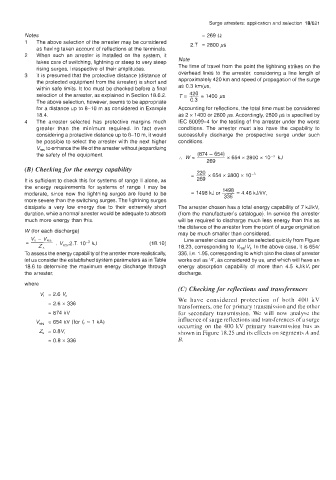Page 656 - Industrial Power Engineering and Applications Handbook
P. 656
Surge arresters: application and selection 18/621
Notes = 269 R
The above selection of the arrester may be considered 2.T = 2800~~
as having taken account of reflections at the terminals.
When such an arrester is installed on the system, it
takes care of switching, lightning or steep to very steep Note
rising surges, irrespective of their amplitudes. The time of travel from the point the lightning strikes on the
It is presumed that the protective distance (distance of overhead lines to the arrester, considering a line length of
the protected equipment from the arrester) is short and approximately 420 km and speed of propagation of the surge
within safe limits. It too must be checked before a final as 0.3 km/,us,
selection of the arrester, as explained in Section 18.6.2. T= ~ 420 = 1400 PS
The above selection, however, seems to be appropriate 0.3
for a distance up to 8-10 m as considered in Example Accounting for reflections, the total time must be considered
18.4. as 2 x 1400 or 2800 ps. Accordingly, 2800 ps is specified by
The arrester selected has protective margins much IEC 60099-4 for the testing of the arrester under the worst
greater than the minimum required. In fact even conditions. The arrester must also have the capability to
considering a protective distance up to 8-10 m, it would successfully discharge the prospective surge under such
be possible to select the arrester with the next higher conditions.
V,, to enhance the life of the arrester without jeopardizing
the safety of the equipment. :. w = (874 - 654) x 654 x 2800 x kJ
269
(B) Checking for the energy capability
_- 220 x 654 x 2800 x
-
It is sufficient to check this for systems of range II alone, as 269
the energy requirements for systems of range I may be
moderate, since now the lightning surges are found to be = 1498 kJ or ~ 1498 = 4.46 kJ/kV,
336
more severe than the switching surges. The lightning surges
dissipate a very low energy due to their extremely short The arrester chosen has a total energy capability of 7 kJ/kVr
duration, while a normal arrester would be adequate to absorb (from the manufacturer’s catalogue). In service the arrester
much more energy than this. will be required to discharge much less energy than this as
the distance of the arrester from the point of surge origination
W (for each discharge)
may be much smaller than considered.
Line arrester class can also be selected quickly from Figure
(1 8.10)
18.23, corresponding to Vres/Vr. In the above case, it is 654/
To assess the energy capability of the arrester more realistically, 336, i.e. 1.95, corresponding to which also the class of arrester
let us consider the established system parameters as in Table works out as ‘4’, as considered by us, and which will have an
18.6 to determine the maximum energy discharge through energy absorption capability of more than 4.5 kJ/kVr per
the arrester, discharge.
where
(C) Checking for reflections and transferences
Vt = 2.6 V,
We have considered protection of both 400 kV
= 2.6 x 336
transformers, one for primary transmission and the other
= 874 kV for secondary transmission. We will now analyse the
influence of surge reflections and transferences of a surge
V,,, = 654 kV (for I, = 1 kA)
occurring on the 400 kV primary transmission bus as
Z, = 0.8Vr shown in Figure 18.25 and its effects on segments A and
= 0.8 x 336 B.

